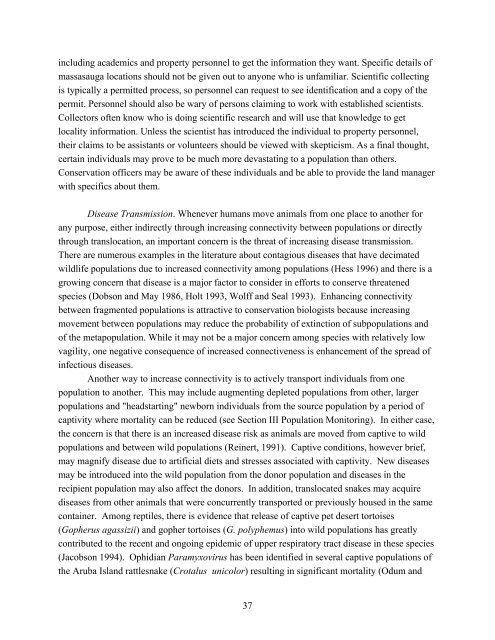The Eastern Massasauga Rattlesnake: - U.S. Fish and Wildlife Service
The Eastern Massasauga Rattlesnake: - U.S. Fish and Wildlife Service
The Eastern Massasauga Rattlesnake: - U.S. Fish and Wildlife Service
You also want an ePaper? Increase the reach of your titles
YUMPU automatically turns print PDFs into web optimized ePapers that Google loves.
including academics <strong>and</strong> property personnel to get the information they want. Specific details of<br />
massasauga locations should not be given out to anyone who is unfamiliar. Scientific collecting<br />
is typically a permitted process, so personnel can request to see identification <strong>and</strong> a copy of the<br />
permit. Personnel should also be wary of persons claiming to work with established scientists.<br />
Collectors often know who is doing scientific research <strong>and</strong> will use that knowledge to get<br />
locality information. Unless the scientist has introduced the individual to property personnel,<br />
their claims to be assistants or volunteers should be viewed with skepticism. As a final thought,<br />
certain individuals may prove to be much more devastating to a population than others.<br />
Conservation officers may be aware of these individuals <strong>and</strong> be able to provide the l<strong>and</strong> manager<br />
with specifics about them.<br />
Disease Transmission. Whenever humans move animals from one place to another for<br />
any purpose, either indirectly through increasing connectivity between populations or directly<br />
through translocation, an important concern is the threat of increasing disease transmission.<br />
<strong>The</strong>re are numerous examples in the literature about contagious diseases that have decimated<br />
wildlife populations due to increased connectivity among populations (Hess 1996) <strong>and</strong> there is a<br />
growing concern that disease is a major factor to consider in efforts to conserve threatened<br />
species (Dobson <strong>and</strong> May 1986, Holt 1993, Wolff <strong>and</strong> Seal 1993). Enhancing connectivity<br />
between fragmented populations is attractive to conservation biologists because increasing<br />
movement between populations may reduce the probability of extinction of subpopulations <strong>and</strong><br />
of the metapopulation. While it may not be a major concern among species with relatively low<br />
vagility, one negative consequence of increased connectiveness is enhancement of the spread of<br />
infectious diseases.<br />
Another way to increase connectivity is to actively transport individuals from one<br />
population to another. This may include augmenting depleted populations from other, larger<br />
populations <strong>and</strong> "headstarting" newborn individuals from the source population by a period of<br />
captivity where mortality can be reduced (see Section III Population Monitoring). In either case,<br />
the concern is that there is an increased disease risk as animals are moved from captive to wild<br />
populations <strong>and</strong> between wild populations (Reinert, 1991). Captive conditions, however brief,<br />
may magnify disease due to artificial diets <strong>and</strong> stresses associated with captivity. New diseases<br />
may be introduced into the wild population from the donor population <strong>and</strong> diseases in the<br />
recipient population may also affect the donors. In addition, translocated snakes may acquire<br />
diseases from other animals that were concurrently transported or previously housed in the same<br />
container. Among reptiles, there is evidence that release of captive pet desert tortoises<br />
(Gopherus agassizii) <strong>and</strong> gopher tortoises (G. polyphemus) into wild populations has greatly<br />
contributed to the recent <strong>and</strong> ongoing epidemic of upper respiratory tract disease in these species<br />
(Jacobson 1994). Ophidian Paramyxovirus has been identified in several captive populations of<br />
the Aruba Isl<strong>and</strong> rattlesnake (Crotalus unicolor) resulting in significant mortality (Odum <strong>and</strong><br />
37

















